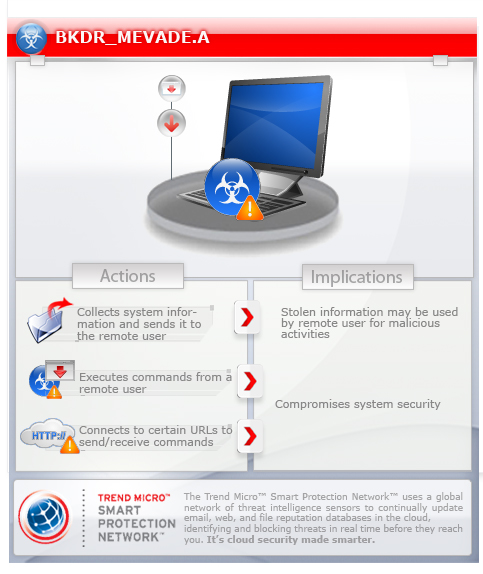BKDR_MEVADE.A
Trojan:Win32/Mevade.A(Microsoft)
Windows 2000, Windows Server 2003, Windows XP (32-bit, 64-bit), Windows Vista (32-bit, 64-bit), Windows 7 (32-bit, 64-bit)


Threat Type: Backdoor
Destructiveness: No
Encrypted: Yes
In the wild: Yes
OVERVIEW
This malware is associated with the reported increase in the number of Tor users. It has the capability to execute commands and download adware on to the infected system. Based on our research, Tor can be used to hide C&C servers.
To get a one-glance comprehensive view of the behavior of this Backdoor, refer to the Threat Diagram shown below.

This backdoor arrives on a system as a file dropped by other malware or as a file downloaded unknowingly by users when visiting malicious sites.
It uses Windows Task Scheduler to create a scheduled task that executes the dropped copy.
It runs certain commands that it receives remotely from a malicious user. Doing this puts the affected computer and information found on the computer at greater risk.
TECHNICAL DETAILS
Arrival Details
This backdoor arrives on a system as a file dropped by other malware or as a file downloaded unknowingly by users when visiting malicious sites.
Installation
This backdoor drops the following copies of itself into the affected system:
- %System%\TrustedInstaller.exe
- %System%\uti.exe
(Note: %System% is the Windows system folder, which is usually C:\Windows\System32.)
It drops the following non-malicious file:
- %System%\~stg
(Note: %System% is the Windows system folder, which is usually C:\Windows\System32.)
It uses Windows Task Scheduler to create a scheduled task that executes the dropped copy.
Autostart Technique
This backdoor registers itself as a system service to ensure its automatic execution at every system startup by adding the following registry entries:
HKEY_LOCAL_MACHINE\SYSTEM\CurrentControlSet\
Services\Trusted Installer
Type = "20"
HKEY_LOCAL_MACHINE\SYSTEM\CurrentControlSet\
Services\Trusted Installer
Start = "02"
HKEY_LOCAL_MACHINE\SYSTEM\CurrentControlSet\
Services\Trusted Installer
ImagePath = "C:\WINDOWS\system32\TrustedInstaller.exe" /svc
HKEY_LOCAL_MACHINE\SYSTEM\CurrentControlSet\
Services\Trusted Installer
DisplayName = "Trusted Installer"
HKEY_LOCAL_MACHINE\SYSTEM\CurrentControlSet\
Services\Trusted Installer
ObjectName = "LocalSystem"
HKEY_LOCAL_MACHINE\SYSTEM\CurrentControlSet\
Services\Trusted Installer
Description = "Adds, modifies, and removes applications provided as a Windows Installer (*.msi) package. If this service is disabled, any services that explicitly depend on it will fail to start."
It registers as a system service to ensure its automatic execution at every system startup by adding the following registry keys:
HKEY_LOCAL_MACHINE\SYSTEM\CurrentControlSet\
Services\Trusted Installer
The scheduled task executes the malware at the following period:
- %Windows%\Tasks\TrustedInstaller Update.job - executes the malware daily every one hour
- %Windows%\Tasks\TrustedInstaller Update 2.job - executes the malware at system startup
(Note: %Windows% is the Windows folder, which is usually C:\Windows.)
Other System Modifications
This backdoor creates the following registry entry(ies) to bypass Windows Firewall:
HKEY_LOCAL_MACHINE\System\CurrentControlSet\
Services\SharedAccess\Parameters\
FirewallPolicy\StandardProfile\AuthorizedApplications\
List
{malware path}\{malware filename}.exe = "{malware path}\{malware filename}.exe:*:Enabled:{malware filename}.exe(in)"
HKEY_LOCAL_MACHINE\System\CurrentControlSet\
Services\SharedAccess\Parameters\
FirewallPolicy\StandardProfile\AuthorizedApplications\
List
%System%\TrustedInstaller.exe = "%System%\TrustedInstaller.exe:*:Enabled:TrustedInstaller.exe(in)"
Backdoor Routine
This backdoor executes the following command(s) from a remote malicious user:
- Perform remote connection to a certain location supplied by the remote user using SSH
- Update copy of itself
It connects to the following URL(s) to send and receive commands from a remote malicious user:
- http://{BLOCKED}statistic.net\er
- http://{BLOCKED}ystatistic.com\er
- http://{BLOCKED}atistic.com\er
- http://{BLOCKED}-update.net\er
- http://{BLOCKED}ice.net\er
- http://{BLOCKED}-stat.com\er
- http://{BLOCKED}statistic.net\br
- http://{BLOCKED}ystatistic.com\br
- http://{BLOCKED}atistic.com\br
- http://{BLOCKED}-update.net\br
- http://{BLOCKED}ice.net\br
- http://{BLOCKED}-stat.com\br
NOTES:
It contains Anti Virtual Machine Execution. It checks for the presence of the following related processes
- VirtualBox
- VMWare
It also includes Anti-Sandbox, where it does not proceed with execution if found running on the following sandbox:
- Sandboxie
It requires the following parameters to be able to execute properly:
- /svc
- /w
- /i
- /r
It collects the following system information, and then sends this information to the remote user:
- UUID
- Operating System
- Installed AV products
- Installed Firewall Products
SOLUTION
Step 1
Before doing any scans, Windows XP, Windows Vista, and Windows 7 users must disable System Restore to allow full scanning of their computers.
Step 2
Disable this malware service
- Trusted Installer
Step 3
Search and delete these files
- %System%\~stg
- %Windows%\Tasks\TrustedInstaller Update.job
- %Windows%\Tasks\TrustedInstaller Update 2.job
Step 4
Delete this registry key
Important: Editing the Windows Registry incorrectly can lead to irreversible system malfunction. Please do this step only if you know how or you can ask assistance from your system administrator. Else, check this Microsoft article first before modifying your computer's registry.
- In HKEY_LOCAL_MACHINE\SYSTEM\CurrentControlSet\Services
- Trusted Installer
- Trusted Installer
Step 5
Delete this registry value
Important: Editing the Windows Registry incorrectly can lead to irreversible system malfunction. Please do this step only if you know how or you can ask assistance from your system administrator. Else, check this Microsoft article first before modifying your computer's registry.
- In HKEY_LOCAL_MACHINE\System\CurrentControlSet\Services\SharedAccess\Parameters\FirewallPolicy\StandardProfile\AuthorizedApplications\List
- {malware path}\{malware filename}.exe = "{malware path}\{malware filename}.exe:*:Enabled:{malware filename}.exe(in)"
- {malware path}\{malware filename}.exe = "{malware path}\{malware filename}.exe:*:Enabled:{malware filename}.exe(in)"
- In HKEY_LOCAL_MACHINE\System\CurrentControlSet\Services\SharedAccess\Parameters\FirewallPolicy\StandardProfile\AuthorizedApplications\List
- %System%\TrustedInstaller.exe = "%System%\TrustedInstaller.exe:*:Enabled:TrustedInstaller.exe(in)"
- %System%\TrustedInstaller.exe = "%System%\TrustedInstaller.exe:*:Enabled:TrustedInstaller.exe(in)"
Step 6
Scan your computer with your Trend Micro product to delete files detected as BKDR_MEVADE.A. If the detected files have already been cleaned, deleted, or quarantined by your Trend Micro product, no further step is required. You may opt to simply delete the quarantined files. Please check this Knowledge Base page for more information.
Did this description help? Tell us how we did.


